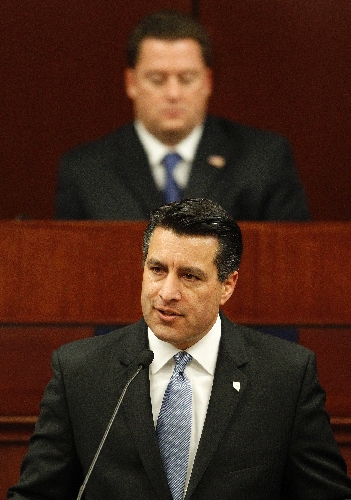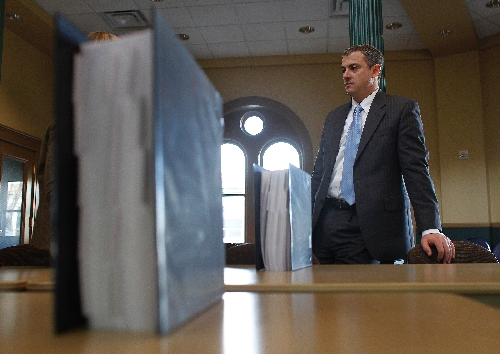Blueprint for Nevada budget contains widespread pain
CARSON CITY -- Nevadans would pay no new taxes under the $5.8 billion 2011-13 budget proposed by Gov. Brian Sandoval on Monday, but a lot of key programs, including public schools and higher education, would suffer big spending cuts.
The proposal would slash a variety of programs statewide, including those for the mentally ill and for autistic children. It also calls for as many as 361 layoffs and 5 percent pay reductions for state workers.
The cure for the state's revenue malady also would hurt local governments by taking a big chunk of their revenues and forcing them to operate or pay for some programs now run by the state.
As he promised during his election, his two-year budget would bring state spending back to the levels in the 2005-07 budget period -- before the great recession hit the nation hard and Nevada even harder.
The governor proposes reducing general fund spending by 6.44 percent, $402 million, but he seeks $1.059 billion in additional revenue through creative financial measures -- not tax increases -- to keep from cutting spending more. The funds would offset about $450 million in increased Medicaid spending and $440 million in revenue that schools are losing because of property tax and sales tax declines.
The proposed measures include the following:
■ Taking $121 million in property tax revenue from Clark and Washoe counties and giving it to the Higher Education System of Nevada to support universities and colleges.
■ Changing a law that requires school districts to maintain a fund with at least one year's worth of the money they need to pay debt service on their bond issues. That would reduce the reserve fund requirement to six months' worth of bond payments. That would free up $425 million, which school districts can use to cover their operating costs. The funds would help replace the money schools are losing because of declines in local property taxes and sales taxes.
■ Taking $213 million in room tax revenue that would have gone to public schools and putting it in the state general fund, where it could be spent on education.
■ Securing $190 million by taking out a 4½-year bond, or loan, on the $240 million the state receives each year in insurance premium taxes. It would be paid off at $50 million annually.
The chances of Republican Sandoval pushing his budget plan unfettered into law appear slim to none because Democrats control both houses of the Legislature.
After the governor's speech, Assembly Speaker-elect John Oceguera, D-Las Vegas, said the Legislature might seek to increase taxes against Sandoval's will.
"This is the right time to shoulder our responsibility and do the right thing for our state," Oceguera said.
State Budget Director Andrew Clinger said Sandoval wants to bring fundamental changes to how budgets are prepared, setting spending priorities and requiring state agencies to meet performance indicators.
"We needed to overhaul the way we did the budget," Clinger said. "We aren't just taking what we spent last year and adding to it."
Whether agencies will be disciplined or lose future funds for not meeting the indicators "depends on the agency" and will be discussed by the administration during legislative hearings, he added.
Geoffery Lawrence, deputy director of policy for the Nevada Policy Research Institute, hailed Sandoval's move toward performance-based budgeting, a goal sought by his conservative Las Vegas think tank and a plan that saved Washington state $2 billion.
"The governor made a clear and compelling case that Nevada's government needs to be driven by the pursuit of results and that an emphasis on performance can produce equal or better results with fewer resources," he said.
PUBLIC SCHOOLS
The governor proposes cutting state worker salaries by 5 percent, saving $453 million, and reducing appropriations to public schools and higher education to force them to cut their employees' pay, too. He proposes continuing the two-year freeze on longevity and merit pay, saving $221 million.
State support for public schools would fall by 5.2 percent to $4,918 per pupil if his budget is approved.
Sandoval proposes letting school districts decide whether to continue class-size reduction, full-day kindergarten and other programs. Instead he wants to provide $325 million in block grants, $18 million less than these programs now cost, and let the schools use it as they see fit.
But Ruben Murillo, president of the Clark County Education Association, said that Sandoval's proposal is almost a 9 percent cut in state support to public education.
"I don't see how much more you can cut the school budget and be an effective school system," Murillo said. "Asking teachers to do more in the face of cutting salaries is just a slap in the face."
Carolyn Edwards, the Clark County School Board president, shared his concerns.
"Without any reductions in state aid, the Clark County School District was already anticipating a budget shortfall of $180 million," Edwards said.
HIGHER EDUCATION
The state's higher education leaders had trouble making sense of Sandoval's proposed cuts.
Sandoval said he was proposing a 7 percent cut to state support for higher education, which would increase to a 17.6 percent cut when adding in the federal stimulus money the system is losing.
But the numbers in the actual budget show a 22.3 percent cut in state support. With the lost stimulus money, the overall cut would be somewhere near 25 percent.
The proposed cuts would follow three years of cuts already made to the system.
The governor justified the cuts by saying the Board of Regents could increase tuition and fees to help make up the gap. Tuition and fees in Nevada are lower than regional and national averages.
But higher education leaders said such cuts would devastate the system. They said there is no way to make up the gap with a tuition increase.
Chancellor Dan Klaich said the system would have to restrict access, raise tuition and maybe restructure entirely if the cuts went through.
He said a 70 percent or higher tuition increase would be needed to make up the gap, especially if 15 percent were set aside for scholarships, as Sandoval indicated he wanted.
James Dean Leavitt, chairman of the Board of Regents, said, "It's going to be very, very difficult" for the system to survive the cuts without parts of it collapsing.
Neal Smatresk, president of the University of Nevada, Las Vegas, said previous cuts have seen the university eliminate departments and freeze jobs.
"I think it's pretty clear that cuts of that magnitude are devastating," he said. "They will assure that not every Nevadan who wants to can get into higher education."
LOCAL GOVERNMENTS
Local governments might be the biggest losers in the Sandoval budget.
Besides taking county taxes to fund higher education, Sandoval wants to keep about $20 million a year in property tax revenue that normally would go to a county indigent care fund for accident victims. About half of this money would have gone to University Medical Center, the county's public hospital.
Sandoval also wants to eliminate funding for the Spring Mountain Youth Camp, close 22 beds in the Rawson-Neal Psychiatric Hospital in Las Vegas and reduce about $20 million in other state payments to counties.
He expects the counties to pay about $80 million to cover costs of youth parole and emergency medical services, mental health courts and other programs that state will continue to provide. If the counties balk at paying these costs, or don't take over the programs, then they will be eliminated by the state.
Clark County Commissioner Steve Sisolak, a former regent, said Sandoval wants the county to funnel "an enormous chunk of money" into state higher education while having no power to determine policies or programs.
"It's shifting of the dollars and not having any control over how those dollars are spent," Sisolak said.
The governor is taking a "Band-Aid approach" instead of tackling the real problems of the state relying too much on gaming and sales taxes, he said.
HUMAN SERVICES
Even by pushing costs to the counties, Department of Health and Human Services Director Mike Willden said he still must cut his costs by $277 million, particularly in mental health programs and in a program to help autistic children.
"There isn't enough money to go around, but it doesn't mean these people won't be receiving services," he said.
Willden said typically there are five or six programs available for the mentally ill and three for autistic children. While they might lose one program, the others still will be available to them.
He also insisted the elimination of some programs will not lead to more mentally ill, homeless people on the streets. The homeless problem might increase because of the poor economy or other factors but not because of the elimination of social service programs, he said.
But Sandoval restored a $60 million program to provide personal care attendants for 6,600 disabled and elderly people. Gov. Jim Gibbons had proposed ending this program.
MEDICAID
The biggest social service expenditure is on Medicaid, the free health care program for the poor, disabled, handicapped and some elderly in which 275,000 Nevadans are enrolled. The number is increasing by 3,000 to 4,000 each month.
Physicians would see a 15 percent cut in the rates the state pays them to see Medicaid patients. Inpatient hospitals, specialty hospitals and psychiatric hospitals would have their Medicaid reimbursement cut by 5 percent. Kathy Silver, UMC's chief executive officer, said Medicaid reimbursements have fallen by 25 percent since 2006 and don't come close to covering the cost of care.
"What it will essentially do is increase the amount of unfunded care the hospital provides to people without resources," said Brian Brannman, the hospital's chief operating officer.
UMC lost $72 million in 2010.
"This is just going to make a bad situation worse," said D. Mitchell Forman, president of the Clark County Medical Association. "With these reimbursement rates, fewer physicians will be available to those without resources. There's no doubt that the number of physicians seeing Medicaid patients will drop.
Dr. Ron Kline, president of the Nevada State Medical Association, said Nevada is last in the United States in its reimbursement rates, and even the territories of Guam and Puerto Rico pay more.
"And that means people who need health care the most will lose access," he said.
Contact Capital Bureau Chief Ed Vogel at evogel@reviewjournal.com or 775-687-3901. Review-Journal reporters Paul Harasim, Ben Spillman, Jim Haug, Scott Wyland and Richard Lake contributed to this report.
Gov. Sandoval's first State of the State speech
Democratic response to State of the State speech
2011-2013 Executive Budget























